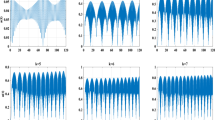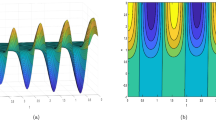Abstract
In this article, we propose the realization of all-optical soliton-based subtractor using hypersecant pulse. As for the need of high-speed modern communication system and digital communication regime, we introduce a new and easy concept to generate all-optical logic design, particularly the logic subtractor using HOSP. The HOSP propagates through a nonlinear medium and they interact with a sufficient phase matching condition. In this paper we analyze the intensity of resultant pulse of hypersecant optical soliton pulse (HOSP) and consider that the intensity is analogous with binary bit. As for particle like characteristics of soliton, we can use this pulse as a digital bit. For difference logic of subtractor we use two HOSP and for borrow logic we use three HOSP with proper phase and amplitude condition. The result as discussed here was simulated by MATLAB simulator with proper programming algorithm. So, the result as theoretically discussed here is satisfied by a simulator and we can get practical implementation of logic subtractor also using optical pulse.





Similar content being viewed by others
References
V.C. Kuriakose, K. Porsezian, Elements of optical solitons: an overview. Resonance 15, 643–666 (2010)
P. Singh, D.K. Tripathi, S. Jaiswal, H.K. Dixit, All-optical logic gates: designs, classification, and comparison. Adv. Opt. Technol. (2014). https://doi.org/10.1155/2014/275083
J. Scheuer, M. Orenstein, All-optical gates facilitated by soliton interactions in a multilayered Kerr medium. J. Opt. Soc. Am. 22, 1260 (2005)
M.N. Islam, All-optical cascadable NOR gate with gain. Opt. Lett. 15, 417 (1990)
X. Liu, K. Beckwitt, F. Wise, Noncollinear generation of optical spatiotemporal solitons and application to ultrafast digital logic. Phys. Rev. E Stat. Phys. Plasmas Fluids Relat. Interdiscip. Top. 61, 4722–4725 (2000)
P. Kuila, Theoretical study of using an amplitude modulation scheme with an electro-optic modulator for generation of the proper power shape function of an optical soliton pulse in a nonlinear waveguide. Opt. Eng. 45, 045002 (2006)
M. Snehalata Mundhe, M. Samata Bhosale, M. Sunaya Shirodkar, Evolution of solitons in optical communication. Int. J. Res. Advent. Technol. 3, 2321–9637 (2015)
E.M. Wright, All-optical switching using solitons. Opt. Quantum Electron. 24, 97–102 (1992)
P. Kuila, A. Sinha, S. Mukhopadhyay, An all-optical remote controlled X-Nor logic using soliton pulse. Optoelectron. Lett. 4, 0365–0368 (2008)
A. Ghadi, S. Sohrabfar, All-optical multiple logic gates based on spatial optical soliton interactions. IEEE Photonics Technol. Lett. 30, 569–572 (2018)
S.K. Garai, S. Mukhopadhyay, A method of optical implementation of frequency encoded different logic operations using second harmonic and difference frequency generation techniques in non-linear material. Opt. Int J. Light Electron. Opt. 121, 715–721 (2010)
A. Raja, K. Mukherjee, J.N. Roy, Design analysis and applications of all-optical multifunctional logic using a semiconductor optical amplifier-based polarization rotation switch. J. Comput. Electron 20, 387–396 (2021)
J. Banerjee, M. Bera, M. Ray, Surface Plasmon Resonance Based Differential Phase Analysis Using Mach-Zehnder Interferometric Set-Up (Springer, Singapore, 2017)
R. Gangwar, S.P. Singh, N. Singh, Soliton based optical communication. Prog. Electromagn. Res. 74, 157–166 (2007)
A.M. Alatwi, A.N.Z. Rashed, A pulse amplitude modulation scheme based on in-line semiconductor optical amplifiers (soas) for optical soliton systems. Indones. J. Electr. Eng. Comput. Sci. 21, 1014–21 (2021)
Eh. Shaik, N. Rangaswamy, Realization of all-optical NAND and NOR logic functions with photonic crystal based NOT, OR and AND gates using De Morgan’s theorem. J. Opt. 47, 8–21 (2018)
Y. Song, X. Shi, C. Wu, D. Tang, H. Zhang, Recent progress of study on optical solitons in fiber lasers. Appl. Phys. Rev. 6, 021313 (2019)
A. Hasegawa, F. Tappert, Transmission of stationary non-linear optical pulses in dispersive dielectric fibre. Appl. Phys. Lett. 23, 171 (1973)
S.K. Turitsyn, B.G. Bale, M.P. Fedoruk, Dispersion-managed solitons in fibre systems and lasers. Phys. Rep. 521, 135–203 (2012)
S.P. Chakkravarthy, V. Arthi, S. Karthikumar, A.N.Z. Rashed, P. Yupapin, I.S. Amiri, Ultra high transmission capacity based on optical first order soliton propagation systems. Results Phys. 12, 512–513 (2019)
H. Thapliyal, N. Ranganathan, A new design of the reversible subtractor circuit. Proc. IEEE Conf. Nanotechnol. pp 1430–1435 (2011)
A. Ghadi, All-optical computing circuits half-subtractor and comparator based on soliton interactions. Optik 227, 166079 (2021). (Stuttg)
S. Thongmee, P.P. Yupapin, All optical half adder/subtractor using dark-bright soliton conversion control. Proc. Eng. 8, 217–222 (2011)
K. Mukherjee, Method of implementation of frequency encoded all optical half adder, half subtractor and full adder based on semiconductor optical amplifiers and add drop multiplexers. Optik 122, 1188–1194 (2011). (Stuttg)
Author information
Authors and Affiliations
Corresponding author
Additional information
Publisher's Note
Springer Nature remains neutral with regard to jurisdictional claims in published maps and institutional affiliations.
Rights and permissions
About this article
Cite this article
Mukherjee, C., Sinha, A. A new theoretical approach to design HOSP-based subtractor. J Opt 52, 254–260 (2023). https://doi.org/10.1007/s12596-022-00871-7
Received:
Accepted:
Published:
Issue Date:
DOI: https://doi.org/10.1007/s12596-022-00871-7




